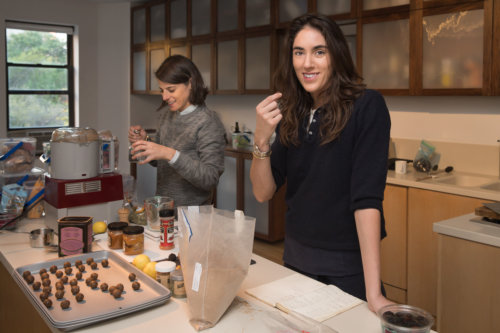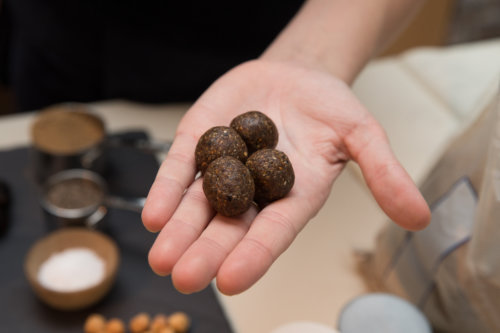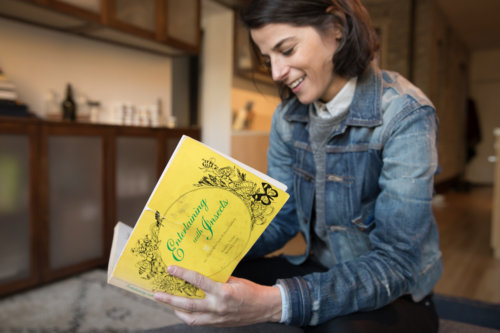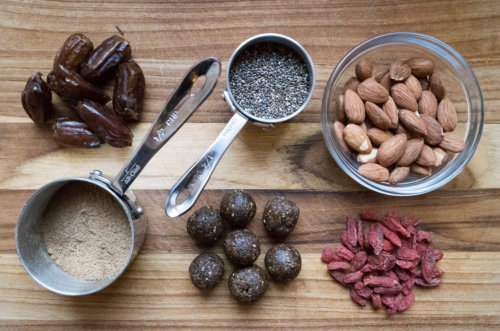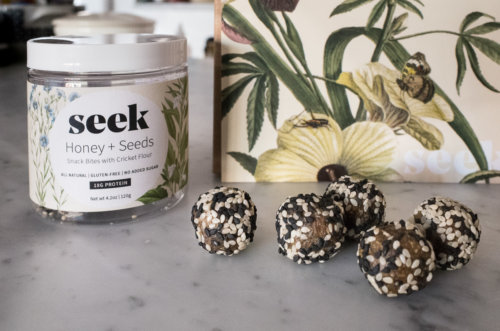
Buggin: In the Kitchen with Insect Snack Entrepreneur Robyn Shapiro
Are crickets kosher? Were my childhood M&Ms laced with ground up insects? Should my kitchen cabinets be stocked with freeze-dried creepy crawlers? These were some of the questions plaguing me after a few hours with Seek Food founder Robyn Shapiro.
On a mild-Fall Saturday afternoon, we met at her East Village apartment. Shapiro was workshopping new recipes for her cricket-laden line of Snack Bites. For me, photographing insects as food seemed more a voyeuristic endeavor than a participatory one, until the cookie dough-like mixture was within reach. Eyeing cashews, coconut flakes, almonds and figs, while ignoring a gaping four-pound bag of cricket flour, I popped a marble-size ball in my mouth.
Researchers have long eyed crickets and other insects as an efficient opportunity to bridge the nutrition gap between rich and poor countries. News stories abound with beetles, dragonfly larvae, and water bugs as the meat of the future. But for Shapiro, the future is now.
Here are highlights from Shapiro’s enthusiastic introduction to her craft.
GC: I understand that you had thousands of crickets shipped to your home after reading a United Nations Food and Agriculture Report. When did insects become a staple in your pantry?
RS: I’d already been cooking with insects for a couple of years in my apartment. I made pasta and crackers and chocolates. I was getting cricket powder in Jackson Heights, Queens. Some of the Thai supermarkets have insects and silk worm paste and ant larvae. It was a scavenger hunt to figure out the best and safest places to source things.
I’ve always had a strong passion for food and I wanted to do something that was additive, with a nod to the future. I read the report word for word and was so convinced.
GC: What other insects are you cooking with?
RS: One that used to be really popular is cochineal, a natural red food dye. Little insects harvested from cacti (they look like little pebbles) but when ground up they create a red dye. Cochineal was used to create the red stripes in Betsy Ross’ American flag. It was used by painters. Vermeer was thought to use it. And it was in every single food product, especially candies. Red Number 4. But people complained. There’s this fear of insects, many would rather eat chemicals.
GC: The NY Health Department issues violations for insects present in sanitary inspections. Is this an issue?
RS: No. The cricket powder in our products is crickets that were raised for human consumption and processed in facilities meant to process food. It’s not a cleanliness issue.
GC: Aside from U.N. reports, what’s on your bedside table?
RS: I’m yet to get a bedside table. But I am working my way through The Third Plate by Dan Barber. And a 1976 cookbook called Entertaining with Insects. Look here– they talk about sourcing insects, celebrations. Chinese New Year. Birthday of Rome. Florentine Cricket Festival– I don’t even know what that is!
Also, Dan Harris’ 10% Happier. My reading list will grow when I travel this winter.
GC: What’s on your itinerary?
RS: Thailand, Sri Lanka, Cambodia, and Japan.
About 80% of the world eats an estimated 2,000 types of insects. Here in America we are very isolated– we think that America is the center of the earth. But as I promote the practice of eating insects I feel a responsibility to bring back the knowledge of how they are consumed around the world, both for cross-cultural understanding as well as just to educate myself and do research.
GC: How do you know which bugs are safe for consumption?
RS: Source from a trusted supplier. There are bugs I buy for private dinners that are actually being raised as pets. But it is best to insure they’ve been raised for human consumption so that you know they haven’t been contaminated with pesticides.
GC: What are some regional and seasonal differences in edible insects?
RS: In the U.S. we started with the cricket.
GC: We have a fertile cricket environment?
RS: It’s not that. If we’re starting with insects, let’s try to pick one with the least amount of negative associations.
Crickets are a warm summer’s night, they make a nice chirping noise, they are not as scary as other insects. They are also very nutritious. They are season-less and climate-less. They can be in any space, urban or rural, big or small.
GC: So crickets are the gateway bug?
RS: Yes. Also, our neighbors in Mexico have a culture of eating crickets and grasshoppers called chapulines. They’re in tacos. A lot of people mention them as their first insect-eating experience.
GC: Which is most popular globally?
RS: The beetle family. Different types of ants are really tasty. Worms are also more popular globally than crickets.
I encourage people to try local food to understand culture. Insects are part of everywhere that’s not Western. Parts of Africa, Southeast Asia, South America… really Western and Middle Eastern cultures are the only places where it is not practiced.
GC: What was your first insect nibble?
RS: Laos. I had cockroaches roasted on skewers. A nice roasted flavor, crunchy, a soft inner-body. But they didn’t taste like much.
I sometimes compare crickets to tofu, depending on what you mix them with, they can take on that flavor.
GC: You’re a former marketing exec. Are snack bites tougher than a piece of cake?
RS: Insects have a negative connotation. They’re polarizing. They’re small, they’re pests, we trample over them. We have a way of giving praise or attention to bigger creatures. But insects contribute about $50B to the US economy as pollinators [and] decomposers of organic material. Each of the Seek Snack Foods has a label with a fact about the benefits of insects.
GC: Let’s eat.
Seek Food Snack Bites are available for $9/container at seek-food.com.


























